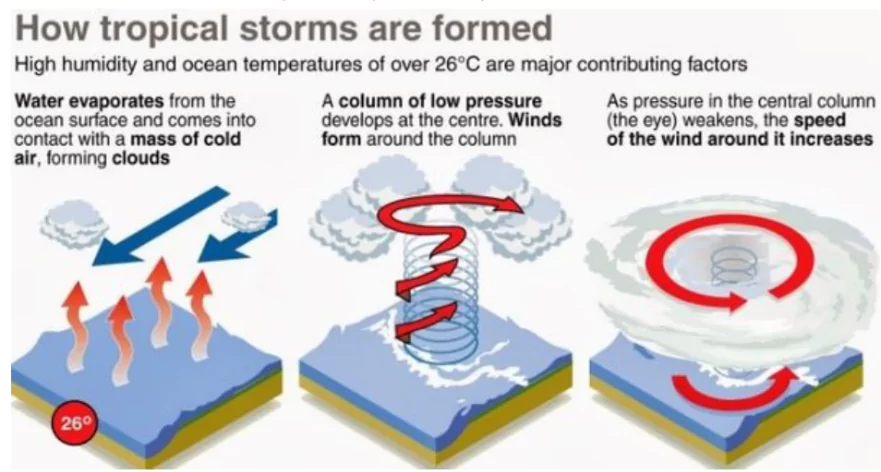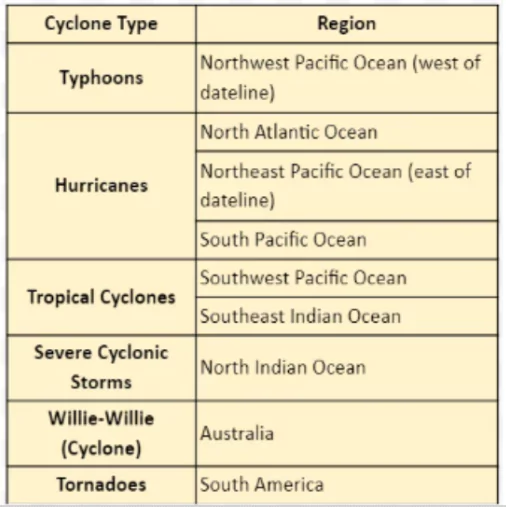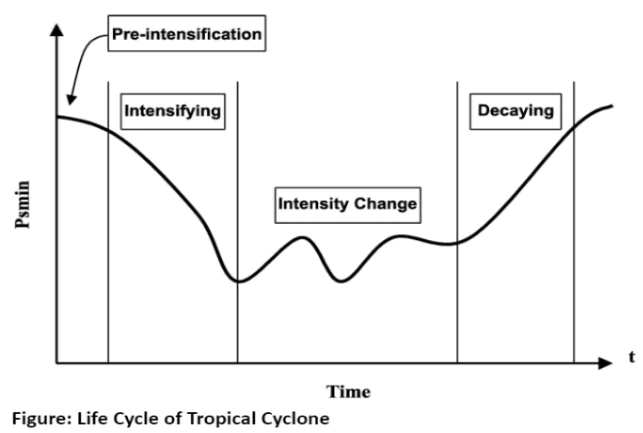They are strong low-pressure center’s that originate over oceans in tropical areas and move over to the coastal areas bringing about large-scale destruction due to violent winds, heavy rainfall (torrential rainfall) and storm surges. They originate in tropical regions and move towards coastlines, causing widespread damage and posing significant threats to communities in their path. With characteristics like a calm eye surrounded by a wall of strong winds, they are known by different names in different regions, such as cyclones, hurricanes, typhoons, and willy-willies.
Tropical Cyclones
Below are the characteristics of Tropical Cyclone:
Characteristics of Tropical Cyclone
- Violent Storms; Originate over oceans in tropical areas.
- Size and Velocity of Cyclones: Cyclones can range in diameter from 50 to 320 km, but their impact covers thousands of square km of ocean and lower atmosphere.
- The most intense effects are concentrated within a radius of about 100 km from the center, where winds can reach speeds of up to 320 km per hour.

- The Eye of a Tropical Cyclone: The eye has the lowest surface pressure and warmest temperatures and air descends at the centre.
 A roughly circular calm area of comparatively light winds and fair weather at the centre.
A roughly circular calm area of comparatively light winds and fair weather at the centre.- The eye temperature may be 10°C warmer or more at an altitude of 12 km than the surrounding environment, but only 0-2°C warmer at the surface in the tropical cyclone [UPSC 2020].
- The eye is surrounded by the eye wall with a strong spiraling ascent of air where winds blow the fastest resulting in torrential rains.
- The Driving Force: Latent Heat of Evaporation released by the condensation of moist rising air over oceans is the driving engine for tropical cyclones.
- Dissipation: They dissipate after they make landfall because the latent heat of evaporation is not available (moisture supply is cut off).
- Path: They move in a parabolic path towards the west under the influence of trade winds.
- Different Names: Cyclones (Indian Ocean), Hurricanes (Atlantic), Typhoons (Western Pacific and South China Sea; Philippines islands, eastern China and Japan ), and Willy-willies (North West Australia).
Enroll now for UPSC Online Course
Favourable Conditions for the Formation of Tropical Cyclone
- Large sea surface with temperature> 27° C;
- Presence of the Coriolis force;
- Small variations in the vertical wind speed;
- A pre-existing weak low-pressure area or low-level-cyclonic circulation and
- Upper divergence above the sea level system.
- In the South Atlantic and South-Eastern Pacific regions in tropical latitudes, cyclones do not originate because of low sea surface temperatures. [UPSC 2015]
Life Cycle of Tropical Cyclones
- Formation Stage: Tropical cyclones begin as clusters of thunderstorms over tropical ocean waters.
- also known as Genesis, the earliest stages of their development,
- The distinction between the genesis and formation stages varies among meteorologists.
 Intensification Stage: During this phase, the central pressure of the cyclone drops, and the maximum surface wind speed increases.
Intensification Stage: During this phase, the central pressure of the cyclone drops, and the maximum surface wind speed increases. -
- If conditions permit, an eye may form at the centre of the cyclone.
- Mature Stage: At this point, the cyclone reaches its peak intensity.
- The central pressure reaches its minimum, and surface winds achieve their maximum strength.
- Decay Stage: As the cyclone weakens, its central pressure rises, and maximum surface winds diminish.
- Decay can result from various factors, such as moving over land or cool water, recurving, or transitioning into an extratropical cyclone.
- Although weakened, decaying cyclones can still produce high winds and heavy rainfall.
Classification of Cyclonic Disturbances
- Socio-Economic Concerns: Tropical cyclones pose significant socio-economic concerns for the Indian subcontinent, which experiences two cyclone seasons annually.
- Impact of Cyclones on India’s Coastline: India’s densely populated coastline faces substantial risks from these natural disasters, contributing to high levels of human loss.
- Variability of Storm Surge: Coastal bathymetry variations result in varying storm surge severities, even for cyclones of the same intensity.
- The Indian Meteorological Department (IMD) has set criteria to classify tropical cyclones in the Bay of Bengal and the Arabian Sea based on their potential for causing damage. These criteria are also used by the World Meteorological Organization (WMO).

Impact of Tropical Cyclone
- Tropical cyclones mainly occur during May-June and October-November in the North Indian Ocean.
- When these cyclones make landfall in the North Indian Ocean, particularly in the Bay of Bengal and the Arabian Sea, they bring destructive winds, storm surges, and heavy rainfall.
- Positive Effects: The Easterly jet stream guides ‘Tropical Depressions’ towards India and contributes significantly to the distribution of monsoon rainfall across the Indian subcontinent.
- Negative Effects: Tropical cyclones lack surface anticyclones, increasing their destructive potential.
- These cyclones cause extensive damage through high winds, storm surges, and heavy rainfall, resulting in uprooted trees, damaged crops, destroyed buildings, vehicles, etc.
- They also contribute to beach erosion.
Enroll now for UPSC Online Classes
Conclusion
- Tropical cyclones are natural phenomena with a distinct life cycle, starting as clusters of thunderstorms and intensifying into powerful storms before eventually weakening and dissipating.
- They are driven by the latent heat of evaporation from warm ocean waters and move in a parabolic path under the influence of trade winds.
- Despite the socio-economic concerns they pose, understanding their formation, characteristics, and impact is essential for mitigating their effects and protecting vulnerable coastal communities.
![]() April 29, 2024
April 29, 2024
![]() 2463
2463
![]() 0
0

 A roughly circular calm area of comparatively light winds and fair weather at the centre.
A roughly circular calm area of comparatively light winds and fair weather at the centre. Intensification Stage: During this phase, the central pressure of the cyclone drops, and the maximum surface wind speed increases.
Intensification Stage: During this phase, the central pressure of the cyclone drops, and the maximum surface wind speed increases. 